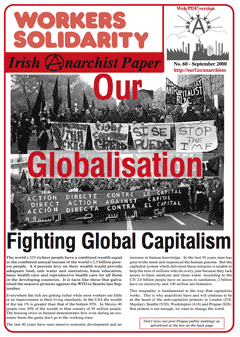Over 30 years of anarchist writing from Ireland listed under hundreds of topics
Is Fight Club an anarchist film?
At the beginning of Fight Club, the unnamed narrator is cracking up. His job is meaningless, his life is empty, and his attempts to fill it by accumulating stuff - Ikea furniture, Calvin Klein clothes - are failing. His constant travelling, and acute insomnia, mean he's no longer sure where, why, or who he is anymore.
He attempts to fill the void by attending support group meetings for diseases - testicular cancer, brain parasites - he doesn't have. There, cocooned by the suffering of the other members, he finds peace, and is able to sleep again. But the peace is shattered when another 'tourist' starts attending meetings. Now he can't release his emotions because the presence of another spectator makes him conscious of his own deception - and the insomnia returns. Until he meets Tyler Durden.
Tyler is everything he isn't - worldly-wise, good-looking, and amoral. And so when he returns home to find his apartment ('his life') destroyed by a gas leak, he moves in to Tyler's delapidated squat, a million miles from his plush apartment. And together they start Fight Club. Fight Club starts small. After a night's drinking, both realise that they've never been in a fight, and trade punches. It's painful, but the pain - unlike his job, his furniture, his whole life - is real and immediate. Soon the fights become the focus of their lives, and others, seeing them, want to join. They don't fight because of any grudges they hold, or for the victory. The fight itself is all that concerns them - a few minutes of direct experience, not bought or sold, not analysed or mediated, but real pain, authentic emotion.
For its members, Fight Club is a liberation. For the rest of the week they have boring and meaningless jobs, bossed around by their superiors, but for one night a week they are all equals. And because of that night of intensity and adrenaline, everything else becomes controllable - your boss is no longer intimidating when he is just another potential opponent.
As Fight Club grows, with more and more members and branches appearing all over the country, so do Tyler's ambitions. The focus of the club shifts from the fights, and towards attacks on the corporate society that created it. Advertisements are subverted, corporate art and fast food chains vandalised, until the final attack on the headquarters of the major credit card companies, an attempt to wipe everyone's slate clean.
Fight Club is an anarchist inspiration to some, fascist propaganda to others, and it's easy to see why opinions are divided. It's an attack on the emptiness of consumerism, the way society robs us of real choice, the void at the heart of capitalism. But the solution it portrays is just as bad. The fighters feel real when they fight, but it's a reality that strips away their individuality.
Their equality is fake - Tyler is always the leader. This becomes more obvious as Fight Club becomes Project Mayhem, where the first rule is not to ask questions. The way it explores these questions would be reason enough to see this film, but it's also one of the best-looking films of recent years. Rent it.
This article is from Workers Solidarity 60 - September 2000

Download the PDF file of WS 60

